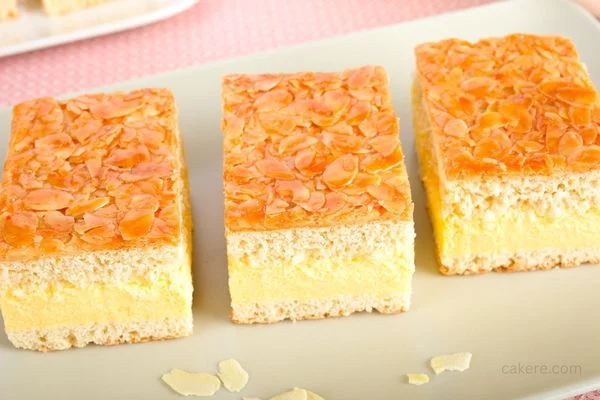Bee Sting Cake, also known as Bienenstich in German, is a delectable pastry with a rich history that dates back several centuries.

Origins of Bee Sting Cake
Bee Sting Cake originated in Germany, where it holds a special place in the hearts of pastry enthusiasts.
This traditional dessert has become an integral part of German culinary heritage and is often associated with certain regions, each with its own unique twist on the recipe.
The Legend of the Bee Sting Cake
Legend has it that the creation of Bee Sting Cake can be attributed to a fateful encounter between a baker and a swarm of bees.
According to popular folklore, a bee landed on a baker’s cake, stinging him as he tried to shoo it away. The baker, in a moment of culinary inspiration, decided to incorporate honey and almonds into his cake, resulting in the birth of the now-famous Bee Sting Cake.
Ingredients and Preparation
Bee Sting Cake features a harmonious blend of ingredients, including a sweet yeast dough base, a rich vanilla custard filling, and a crunchy almond topping.
The process of making this cake involves meticulous attention to detail, with each layer crafted to perfection. From the preparation of the dough to the careful assembly of the cake, it is a labor of love.
Bee Sting Cake’s Popularity and Spread
Over the centuries, Bee Sting Cake’s popularity has transcended borders, captivating the taste buds of dessert enthusiasts worldwide. Its reputation has spread far beyond Germany, and variations of the cake can now be found in various countries. This global recognition is a testament to the cake’s irresistible flavor and unique texture.
Cultural Significance
Bees hold great symbolism in different cultures, representing diligence, cooperation, and sweetness. The Bee Sting Cake, with its honey-infused goodness, has become a symbol of celebration and tradition in many societies.
It is often enjoyed during special occasions, such as weddings, birthdays, and holidays, bringing people together to savor its irresistible taste and honor the cultural heritage associated with it.
Modern Interpretations and Variations
As culinary trends evolve, creative bakers have put their own spin on the traditional Bee Sting Cake.
These modern interpretations include unique flavor combinations, alternative fillings such as fruit compotes or chocolate ganache, and innovative presentations. Some chefs have even fused elements of other cuisines, introducing exciting twists to this classic dessert.
Bee Sting Cake in Popular Culture
The fame of Bee Sting Cake extends beyond the realm of culinary delight. This delectable treat has made appearances in literature, movies, and television shows, often symbolizing heritage, nostalgia, and the pleasures of indulgence.
Its presence in popular culture serves as a reminder of the cake’s enduring legacy and the joy it brings to those who experience it.
Health Benefits of Bee Sting Cake
While Bee Sting Cake is undoubtedly a treat meant to be savored, it also offers certain health benefits. The cake’s key ingredients, such as honey and almonds, provide nutritional value.
Honey contains antioxidants and antimicrobial properties, while almonds are a good source of healthy fats and essential nutrients. However, it is important to enjoy Bee Sting Cake in moderation as part of a balanced diet.
FAQs
The name “Bee Sting Cake” derives from the legend of a bee sting inspiring its creation. It pays homage to the sweet flavors of honey and almonds used in the cake.
Yes, you can experiment with ingredient substitutions to cater to specific dietary needs. For example, you can use gluten-free flour or vegan alternatives for milk and butter.
Through travel, cultural exchange, and the love for delightful desserts, Bee Sting Cake’s reputation spread beyond Germany. It captured the attention of pastry enthusiasts worldwide, leading to its international recognition.
Yes, several renowned bakeries have gained fame for their exceptional Bee Sting Cake. Some notable examples include Schmidt’s Bakery in Germany, Bouchon Bakery in the United States, and Beatrix in Australia.
The traditional Bee Sting Cake recipe contains ingredients such as milk, eggs, and butter, making it unsuitable for strict vegans. However, creative adaptations using vegan substitutes can cater to a vegan lifestyle while still capturing the essence of the cake’s flavors.
Conclusion
The history of Bee Sting Cake is steeped in tradition, legends, and the artistry of pastry-making. From its humble origins in Germany to its global recognition today, this delightful dessert has captured the hearts and taste buds of people around the world.
